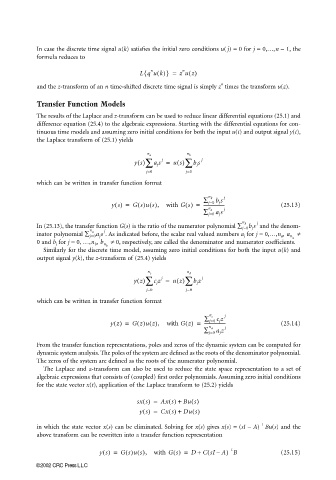Page 807 - The Mechatronics Handbook
P. 807
0066_Frame_C25 Page 6 Wednesday, January 9, 2002 7:05 PM
In case the discrete time signal u(k) satisfies the initial zero conditions u( j) = 0 for j = 0,…,n − 1, the
formula reduces to
n
{
n
Lq uk()} = z uz()
n
and the z-transform of an n time-shifted discrete time signal is simply z times the transform u(z).
Transfer Function Models
The results of the Laplace and z-transform can be used to reduce linear differential equations (25.1) and
difference equation (25.4) to the algebraic expressions. Starting with the differential equations for con-
tinuous time models and assuming zero initial conditions for both the input u(t) and output signal y(t),
the Laplace transform of (25.1) yields
n a n b
ys() ∑ a j s = us() ∑ b j s j
j
j=0 j=0
which can be written in transfer function format
n j
b
∑ j=0 b j s
ys() = Gs()us(), with Gs() = ------------------- (25.13)
n a j
∑ j=0 a j s
n b j
In (25.13), the transfer function G(s) is the ratio of the numerator polynomial ∑ j=0 b j s and the denom-
n a j
inator polynomial ∑ j=0 a j s . As indicated before, the scalar real valued numbers a j for j = 0,…,n a , a n ≠
a
≠ 0, respectively, are called the denominator and numerator coefficients.
0 and b j for j = 0, …,n b , b n
b
Similarly for the discrete time model, assuming zero initial conditions for both the input u(k) and
output signal y(k), the z-transform of (25.4) yields
n c n d
j
yz() ∑ c j z = uz() ∑ b j z j
j=0 j=0
which can be written in transfer function format
n j
c
∑ j=0 c j z
yz() = Gz()uz(), with Gz() = ------------------- (25.14)
n a j
∑ j=0 a j z
From the transfer function representations, poles and zeros of the dynamic system can be computed for
dynamic system analysis. The poles of the system are defined as the roots of the denominator polynomial.
The zeros of the system are defined as the roots of the numerator polynomial.
The Laplace and z-transform can also be used to reduce the state space representation to a set of
algebraic expressions that consists of (coupled) first order polynomials. Assuming zero initial conditions
for the state vector x(t), application of the Laplace transform to (25.2) yields
sx s() = Ax s() + Bu s()
ys() = Cx s() + Du s()
−1
in which the state vector x(s) can be eliminated. Solving for x(s) gives x(s) = (sI − A) Bu(s) and the
above transform can be rewritten into a transfer function representation
(
ys() = Gs()us(), with Gs() = D + C sI A) B (25.15)
1
–
–
©2002 CRC Press LLC

